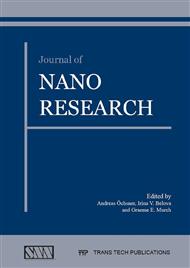[1]
A. Punnoose, H. Magnone, M. S. Seehra, J. Bonevich, Bulk to nanoscale magnetism and exchange bias in CuO nanoparticles, Phys. Rev. B: Condens. Matter Mater. Phys. 64 (2001) 174420-1-8.
DOI: 10.1103/physrevb.64.174420
Google Scholar
[2]
P. Calvert, Inkjet Printing for Materials and Devices, Chem. Mater. 13 (2001) 3299-3305.
DOI: 10.1021/cm0101632
Google Scholar
[3]
G. De, A. Licciulli, M. Nacucchi, Uniformly dispersed Pr+3 doped silica glass by the sol-gel process, J. Non-Cryst. Solids. 201 (1996) 153-158.
DOI: 10.1016/0022-3093(96)00166-4
Google Scholar
[4]
P.M.T. Cavalcante, M. Dondi, G: Guarini, M. Raimondo, G. Baldi, Colour performance of ceramic nano-pigments, Dyes Pigm. 80 (2009) 226-232.
DOI: 10.1016/j.dyepig.2008.07.004
Google Scholar
[5]
S.K. Biswas, D. Dhak, A. Pathak, P. Prananik, Chemical synthesis of environment-friendly nanosized yellow titanate pigments, Mater. Res. Bull. 43 (2008) 665-675.
DOI: 10.1016/j.materresbull.2007.04.001
Google Scholar
[6]
I.S. Ahmed, H.A. Dessouki, A.A. Ali, Synthesis and characterization of new nano-particles as blue ceramic pigment, Spectrochim. Acta, Part A. 71 (2008) 616-620.
DOI: 10.1016/j.saa.2007.12.050
Google Scholar
[7]
M. Jansen, H. P. Letschert, Inorganic yellow-red pigments without toxic metals, Nature. 404 (2000) 980-982.
DOI: 10.1038/35010082
Google Scholar
[8]
V.D. Luz, M. Prades, H. Beltrán, E. Cordoncillo, Environmental-friendly yellow pigment based on Tb and M (M = Ca or Ba) co-doped Y2O3, J. Eur. Ceram. Soc, 33 (2013) 3359-3368.
DOI: 10.1016/j.jeurceramsoc.2013.05.021
Google Scholar
[9]
A. García, M. Llusar, J. Calbo, M. A. Tena and G. Monrós, Low-toxicity red ceramic pigments for porcelainised stoneware from lanthanide–cerianite solid solutions, Green Chem, 3 (2001) 238-242.
DOI: 10.1039/b105830b
Google Scholar
[10]
Y. Marinova, J.M. Hohemberger, E. Cordoncillo, P. Escribano, J.B. Carda, Study of solid solutions, with perovskite structure, for application in the field of the ceramic pigments, J. Eur. Ceram. Soc, 23 (2003) 213-220.
DOI: 10.1016/s0955-2219(02)00182-6
Google Scholar
[11]
V.S. Vishnu, M.L. Reddy, Near-infrared reflecting inorganic pigments based on molybdenum and praseodymium doped yttrium cerate Synthesis, characterization and optical properties, Sol. Energy Mater. Sol. Cells, 95 (2011) 2685-2692.
DOI: 10.1016/j.solmat.2011.05.042
Google Scholar
[12]
J.H. Meng, G.Q. Yang, L.M. Yan, X.Y. Wang, Synthesis and characterization of magnetic nanometer pigment Fe3O4, Dyes Pigm, 66 (2005) 109-113.
DOI: 10.1016/j.dyepig.2004.08.016
Google Scholar
[13]
S. Ahmadi, A. Aghaei, B.E. Yekta, Synthesis of Y(Al, Cr)O3 red pigments by co-precipitation method and their interactions with glazes, Ceram. Int, 35 (2009) 3485-3488.
DOI: 10.1016/j.ceramint.2009.04.029
Google Scholar
[14]
A.F. Osorio, E.P. Villanueva, J.C. Fernaandez, Synthesis of nanosized (Zn1−xCox)Al2O4 spinels New pink ceramic pigments, Mater. Res. Bull, 47 (2012) 445-452.
DOI: 10.1016/j.materresbull.2011.10.024
Google Scholar
[15]
M.S. Niasari, M.F. Khouzanim F. Davar, Bright blue pigment CoAl2O4 nanocrystals prepared by modified sol–gel method, J. Sol-Gel Sci. Technol 52 (2009) 321-327.
DOI: 10.1007/s10971-009-2050-y
Google Scholar
[16]
S. Chemlal, A. Larbot, M. Persin, J. Sarrazin, M. Sghyar, M. Rafiq, Cobalt spinel CoAl2O4 via sol-gel process elaboration and surface properties, Mater. Res. Bull, 35 (2000) 2515-2523.
DOI: 10.1016/s0025-5408(00)00444-x
Google Scholar
[17]
S. Ardizzone, G. Cappelletti, P. Fermo, C. Oliva, M. Scavini, F. Scime`, Synthesis of nanosized (Zn1−xCox)Al2O4 spinels New pink ceramic pigments, J. Phys. Chem. B, 109 (2005) 22112-22119.
DOI: 10.1021/jp054254o
Google Scholar
[18]
Z. Chen, E. Shi, W. Li, Y. Zheng, W. Zhong, Hydrothermal synthesis and optical property of nano-sized CoAl2O4 pigment, Mater. Lett, 55 (2002) 281-284.
DOI: 10.1016/s0167-577x(02)00378-6
Google Scholar
[19]
G. Wei, J. Qu, Z. Yu, Y. Li, Q. Guo, T. Qi, Mineralizer effects on the synthesis of amorphous chromium hydroxide and chromium oxide green pigment using hydrothermal reduction method, Dyes Pigm, 113 (2015) 487-495.
DOI: 10.1016/j.dyepig.2014.09.021
Google Scholar
[20]
H. Fathi, J.P. Kelly, V.R. Vasquez, O.A. Graeve, Ionic Concentration Effects on Reverse Micelle Size and Stability Implications for the Synthesis of Nanoparticles, J. Am. Chem. Soc, 28 (2012) 9267-9274.
DOI: 10.1021/la300586f
Google Scholar


